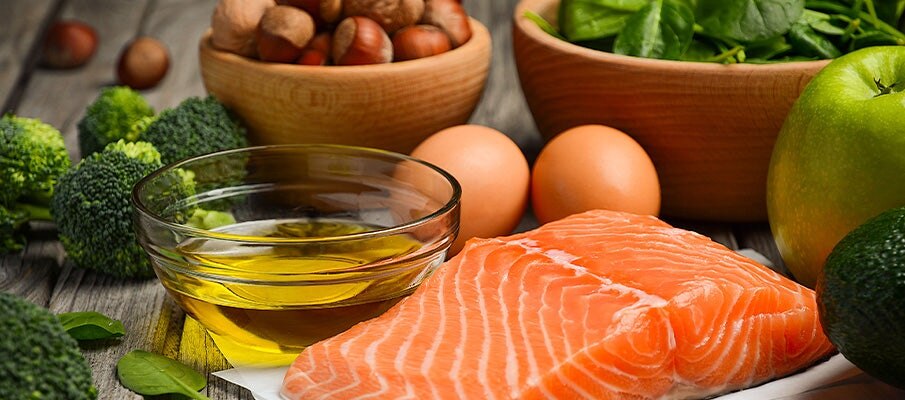The Best Omega-3 Food Sources
- 6/12/23


Omega-3 fatty acids are a type of healthy fat essential in supporting optimal health and well-being. These essential fatty acids play an important role in the health of your heart, as well as supporting your immune system and eye health.
Let’s explore the different types of omega-3 fatty acids, their health benefits, and the best omega-3 foods to help you meet your needs for this important nutrient.
What Are Omega-3 Fatty Acids?
You’ve likely heard the buzz surrounding omega-3 fatty acids. But what are they, and why do we need them? Omega-3 fatty acids are a type of polyunsaturated fat essential for supporting your optimal health and well-being. These fats are considered essential because your body does not produce them, so they must be acquired through food sources.
There are three main types of omega-3 fatty acids which include:
- alpha-linolenic acid (ALA)
- eicosapentaenoic acid (EPA)
- docosahexaenoic acid (DHA)
ALA can be found in plant sources like soybeans, chia seeds, and flaxseeds. EPA and DHA are mostly found in animal sources like fish, fish oils, and krill oils. ALA is a precursor to EPA and DHA, but the conversion rate is low, so it’s best to find direct sources of all three.
Health Benefits of Omega-3 Foods
Omega-3 fatty acids are critical to optimal cell functioning and play an important role in supporting your various body systems. Here are some of the health benefits linked with omega-3s:
Supports heart health
Omega-3s can support your heart health by helping support normal triglyceride levels, a type of fat found in your blood linked to a build-up of plaque in the artery walls. In fact, studies have found that omega-3 supplementation may also help support healthy levels of HDL (good) cholesterol.
Additionally, EPA and DHA supplementation appears to support your heart health by helping to maintain healthy blood pressure. Omega-3s also support your body’s normal inflammatory response, which can be especially helpful in supporting the health of your heart.
Protects your eyes and vision
Omega-3 fatty acids, particularly DHA, are important for protecting the health of your eyes at various stages of life. When you’re born, omega-3 fatty acids are critical for the development of optimal infant vision. Many studies have discovered that adequate omega-3s are associated with improvements in visual acuity (sharpness) and psychomotor development among infants.
As we age, omega-3 fatty acids may help support eye health later in life.
Supports your immune system
Emerging research is shedding light on how omega-3s can help support your immune system. One 2019 study examined the effects of omega-3 fatty acids on different cells within the immune system. Researchers found that DHA and EPA can help activate and enhance the function of important immune cells like white blood cells, known as B cells.
How Much Omega-3 Do I Need?
How much omega-3 you need will depend on a variety of factors, including your age, gender, medication use, and health status. The adequate intake (AI) for omega-3s is as follows:
|
Age |
Omega 3 dosage per day * As total omega-3s ** As ALA |
|---|---|
|
Birth to 6 months |
0.5 g |
|
7–12 months* |
0.5 g |
|
1–3 years* |
0.7 g |
|
4–8 years** |
0.9 g |
|
9–13 years** |
1.2 g (males), 1.0 g (females) |
|
14–51+** |
1.6 g (males), 1.1 g (females) |
|
Pregnant women |
1.4 g |
|
Lactating women |
1.3 g |
The American Heart Association recommends eating two servings of omega-3 foods like fish (3-4 ounces) a week for healthy adults, equivalent to a daily total of 500 milligrams (mg) of EPA and DHA.
However, it’s important to note that many people are not getting enough EPA and DHA in their daily diet to meet the current recommendations. Therefore, omega-3 supplementation is one of the most commonly used dietary supplements by adults and children in the US.
Omega-3 Foods
Omega 3 fatty acids can be found in both animal and plant-based foods. Some of the best animal sources of omega-3s come from fatty fish and fish oil foods, while plant-based options may include certain nuts and seeds.
Fish and seafood sources of omega-3s
The best sources of omega-3s are typically found in fatty fish like salmon, herring, mackerel, and trout. Other sources of animal-based DHA foods include oysters, sardines, and shrimp. A DHA food list may also contain fish oil, like cod liver oil or krill oil, both of which provide a hefty dose of DHA per tablespoon.
Non-fish sources of omega-3s
Foods high in omega-3 that are not fish include a wide variety of nuts, seeds, and beans. The following are vegan sources of omega-3 foods:
- Flaxseeds and flaxseed oil
- Chia seeds
- Hemp seeds
- Walnuts
- Edamame
- Kidney beans
- Soybeans and soybean oil
- Wheat germ
Algae and seaweed are also non-fish sources of omega-3s. These sources are especially important for people following a vegetarian or vegan diet because they are one of the few plant-based foods that contain both DHA and EPA.
Fortified foods and drinks
Sources of omega 3 and 6 can be found in some products that are fortified with the nutrient. For example, some omega-3 products may include certain brands of eggs, yogurt, juices, milk, and soy beverages, which can contain DHA along with other omega-3s.
Omega-3 Supplements
Omega-3 supplementation has skyrocketed in popularity, with people looking to reap their many health benefits. These supplements may include fish oil or omega-3, which provides both EPA and DHA. You may also find omega-3 supplements sourced from krill oil or cod liver oil containing EPA and DHA.
Garden of Life Minami Omega-3 Daily Maintenance Fish Oil is a concentrated omega-3 supplement made from the purest fish oil utilizing dual supercritical CO2 extraction technology that provides both EPA (590mg) and DHA (130mg) in just one soft gel. The formula goes through rigorous in-house and third-party testing and has remarkably low levels of oxidation as well as undetectable levels of dioxins, common pesticides, and heavy metals such as mercury.
You may also find omega-3 supplements made from algal oil, a vegetarian source that comes from algae. If you’re looking for a high-quality vegan omega-3 supplement, consider Minami Algae Omega-3 Vegan DHA Softgels. This is a 100% Vegan DHA is made from algae (Schizochytrium) oil and delivers 500mg of Vegan DHA in just two small soft gels.
For more information on vegan sources of omega-3s, enjoy reading The Vegan’s Essential Guide to Omega-3 Fatty Acids.
Garden of Life offers a wide selection of high-quality omega-3 supplements, including prenatal, kids, and vegan formulas. Garden of Life omega-3 supplements are sustainably sourced and are offered in great-tasting soft gels or original cod liver oil liquid.
Takeaway
Omega-3 fatty acids are essential nutrients that are needed to support your overall health and well-being. More specifically, omega 3s have been found to support various body systems, including the circulatory, immune, and nervous systems.
Omega 3-6-9 foods may include fish, nuts, seeds, certain oils, and fortified foods. Fish remains one of the best sources of omega-3s. Therefore, your fish with omega 3 fatty acids list may contain salmon, herring, mackerel, trout, and fish oils like krill oil and cod liver oil.
While omega-3 fatty acids can be found in some foods, many people are turning to supplementation to meet their needs for this important nutrient.
References
-
Burns-Whitmore B, Froyen E, Heskey C, Parker T, San Pablo G. Alpha-Linolenic and Linoleic Fatty Acids in the Vegan Diet: Do They Require Dietary Reference Intake/Adequate Intake Special Consideration? Nutrients. 2019;11(10):2365. Published 2019 Oct 4. doi:10.3390/nu11102365
-
Chaddha, Ashish & Eagle, Kim. (2015). Omega-3 Fatty Acids and Heart Health. Circulation. 132. e350-e352. 10.1161/CIRCULATIONAHA.114.015176.
-
Zhang X, Ritonja JA, Zhou N, Chen BE, Li X. Omega-3 Polyunsaturated Fatty Acids Intake and Blood Pressure: A Dose-Response Meta-Analysis of Randomized Controlled Trials. J Am Heart Assoc. 2022 Jun 7;11(11):e025071. doi: 10.1161/JAHA.121.025071. Epub 2022 Jun 1. PMID: 35647665; PMCID: PMC9238708.
-
Shulkin M, Pimpin L, Bellinger D, Kranz S, Fawzi W, Duggan C, Mozaffarian D. n-3 Fatty Acid Supplementation in Mothers, Preterm Infants, and Term Infants and Childhood Psychomotor and Visual Development: A Systematic Review and Meta-Analysis. J Nutr. 2018 Mar 1;148(3):409-418. doi: 10.1093/jn/nxx031. PMID: 29546296; PMCID: PMC6251555.
-
Zhang AC, Singh S, Craig JP, Downie LE. Omega-3 Fatty Acids and Eye Health: Opinions and Self-Reported Practice Behaviors of Optometrists in Australia and New Zealand. Nutrients. 2020 Apr 22;12(4):1179. doi: 10.3390/nu12041179. PMID: 32331489; PMCID: PMC7230711.
-
Gutiérrez S, Svahn SL, Johansson ME. Effects of Omega-3 Fatty Acids on Immune Cells. Int J Mol Sci. 2019 Oct 11;20(20):5028. doi: 10.3390/ijms20205028. PMID: 31614433; PMCID: PMC6834330.
-
Office of Dietary Supplements-Omega-3 Fatty Acids. NIH Office of Dietary Supplements. U.S. Department of Health and Human Services. Available at: https://ods.od.nih.gov/factsheets/Omega3FattyAcids-HealthProfessional/ (Accessed: April 13, 2023).
-
Consuming About 3 Grams of Omega-3 Fatty Acids A Day May Lower Blood Pressure (2023) www.heart.org. Available at: https://www.heart.org/en/news/2022/06/01/consuming-about-3-grams-of-omega-3-fatty-acids-a-day-may-lower-blood-pressure (Accessed: April 13, 2023)




